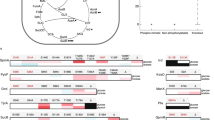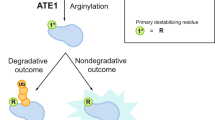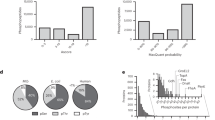Abstract
Protein phosphorylation regulates key processes in all organisms. In Gram-positive bacteria, protein arginine phosphorylation plays a central role in protein quality control by regulating transcription factors and marking aberrant proteins for degradation. Here, we report structural, biochemical, and in vivo data of the responsible kinase, McsB, the founding member of an arginine-specific class of protein kinases. McsB differs in structure and mechanism from protein kinases that act on serine, threonine, and tyrosine residues and instead has a catalytic domain related to that of phosphagen kinases (PhKs), metabolic enzymes that phosphorylate small guanidino compounds. In McsB, the PhK-like phosphotransferase domain is structurally adapted to target protein substrates and is accompanied by a novel phosphoarginine (pArg)-binding domain that allosterically controls protein kinase activity. The identification of distinct pArg reader domains in this study points to a remarkably complex signaling system, thus challenging simplistic views of bacterial protein phosphorylation.
This is a preview of subscription content, access via your institution
Access options
Access Nature and 54 other Nature Portfolio journals
Get Nature+, our best-value online-access subscription
$29.99 / 30 days
cancel any time
Subscribe to this journal
Receive 12 print issues and online access
$259.00 per year
only $21.58 per issue
Buy this article
- Purchase on Springer Link
- Instant access to full article PDF
Prices may be subject to local taxes which are calculated during checkout






Similar content being viewed by others
References
Cohen, P. The origins of protein phosphorylation. Nat. Cell Biol. 4, E127–E130 (2002).
Hunter, T. Signaling–2000 and beyond. Cell 100, 113–127 (2000).
Hunter, T. Protein kinases and phosphatases: the yin and yang of protein phosphorylation and signaling. Cell 80, 225–236 (1995).
Eckhart, W., Hutchinson, M. A. & Hunter, T. An activity phosphorylating tyrosine in polyoma T antigen immunoprecipitates. Cell 18, 925–933 (1979).
Waksman, G. et al. Crystal structure of the phosphotyrosine recognition domain SH2 of v-src complexed with tyrosine-phosphorylated peptides. Nature 358, 646 (1992).
Seet, B. T., Dikic, I., Zhou, M. M. & Pawson, T. Reading protein modifications with interaction domains. Nat. Rev. Mol. Cell Biol. 7, 473–483 (2006).
Jin, J. & Pawson, T. Modular evolution of phosphorylation-based signalling systems. Philos. Trans. R. Soc. Lond. B Biol. Sci. 367, 2540–2555 (2012).
Pallen, M., Chaudhuri, R. & Khan, A. Bacterial FHA domains: neglected players in the phospho-threonine signalling game? Trends Microbiol. 10, 556–563 (2002).
Hoch, J. A. & Varughese, K. I. Keeping signals straight in phosphorelay signal transduction. J. Bacteriol. 183, 4941–4949 (2001).
Elsholz, A. K. et al. Global impact of protein arginine phosphorylation on the physiology of Bacillus subtilis. Proc. Natl Acad. Sci. USA 109, 7451–7456 (2012).
Schmidt, A. et al. Quantitative phosphoproteomics reveals the role of protein arginine phosphorylation in the bacterial stress response. Mol. Cell Proteomics 13, 537–550 (2014).
Trentini, D. B. et al. Arginine phosphorylation marks proteins for degradation by a Clp protease. Nature 539, 48–53 (2016).
Trentini, D. B., Fuhrmann, J., Mechtler, K. & Clausen, T. Chasing phosphoarginine proteins: development of a selective enrichment method using a phosphatase trap. Mol. Cell Proteomics 13, 1953–1964 (2014).
Bäsell, K. et al. The phosphoproteome and its physiological dynamics in Staphylococcus aureus. Int. J. Med. Microbiol. 304, 121–132 (2014).
Junker, S. et al. Spectral library based analysis of arginine phosphorylations in Staphylococcus aureus. Mol. Cell Proteomics 17, 335–348 (2018).
Mijakovic, I., Grangeasse, C. & Turgay, K. Exploring the diversity of protein modifications: special bacterial phosphorylation systems. FEMS Microbiol. Rev. 40, 398–417 (2016).
Wozniak, D. J., Tiwari, K. B., Soufan, R. & Jayaswal, R. K. The mcsB gene of the clpC operon is required for stress tolerance and virulence in Staphylococcus aureus. Microbiology 158, 2568–2576 (2012).
Singh, L. K. et al. P. clpC operon regulates cell architecture and sporulation in Bacillus anthracis. Environ. Microbiol. 17, 855–865 (2015).
Schumann, W. Regulation of bacterial heat shock stimulons. Cell Stress Chaperones 21, 959–968 (2016).
Fuhrmann, J. et al. McsB is a protein arginine kinase that phosphorylates and inhibits the heat-shock regulator CtsR. Science 324, 1323–1327 (2009).
Fuhrmann, J. et al. Structural basis for recognizing phosphoarginine and evolving residue-specific protein phosphatases in gram-positive bacteria. Cell Rep. 3, 1832–1839 (2013).
Kruger, E., Msadek, T., Ohlmeier, S. & Hecker, M. The Bacillus subtilis clpC operon encodes DNA repair and competence proteins. Microbiology 143, 1309–1316 (1997). Pt 4-1309.
Suzuki, T., Soga, S., Inoue, M. & Uda, K. Characterization and origin of bacterial arginine kinases. Int. J. Biol. Macromol. 57, 273–277 (2013).
Ellington, W. R. Evolution and physiological roles of phosphagen systems. Annu. Rev. Physiol. 63, 289–325 (2001).
Zhou, G. et al. Transition state structure of arginine kinase: implications for catalysis of bimolecular reactions. Proc. Natl Acad. Sci. USA 95, 8449–8454 (1998).
Yousef, M. S., Fabiola, F., Gattis, J. L., Somasundaram, T. & Chapman, M. S. Refinement of the arginine kinase transition-state analogue complex at 1.2 A resolution: mechanistic insights. Acta Crystallogr. D Biol. Crystallogr. 58, 2009–2017 (2002).
Summerton, J. C., Evanseck, J. D. & Chapman, M. S. Hyperconjugation-mediated solvent effects in phosphoanhydride bonds. J. Phys. Chem. A 116, 10209–10217 (2012).
Pruett, P. S. et al. The putative catalytic bases have, at most, an accessory role in the mechanism of arginine kinase. J. Biol. Chem. 278, 26952–26957 (2003).
Gattis, J. L., Ruben, E., Fenley, M. O., Ellington, W. R. & Chapman, M. S. The active site cysteine of arginine kinase: structural and functional analysis of partially active mutants. Biochemistry 43, 8680–8689 (2004).
Kruger, E., Zuhlke, D., Witt, E., Ludwig, H. & Hecker, M. Clp-mediated proteolysis in Gram-positive bacteria is autoregulated by the stability of a repressor. EMBO J. 20, 852–863 (2001).
Yousef, M. S. et al. Induced fit in guanidino kinases—comparison of substrate-free and transition state analog structures of arginine kinase. Protein Sci. 12, 103–111 (2003).
Azzi, A., Clark, S. A., Ellington, W. R. & Chapman, M. S. The role of phosphagen specificity loops in arginine kinase. Protein Sci. 13, 575–585 (2004).
Suzuki, T., Kawasaki, Y., Furukohri, T. & Ellington, W. R. Evolution of phosphagen kinase. VI. Isolation, characterization and cDNA-derived amino acid sequence of lombricine kinase from the earthworm Eisenia foetida, and identification of a possible candidate for the guanidine substrate recognition site. Biochim. Biophys. Acta 1343, 152–159 (1997).
Davulcu, O., Flynn, P. F., Chapman, M. S. & Skalicky, J. J. Intrinsic domain and loop dynamics commensurate with catalytic turnover in an induced-fit enzyme. Structure 17, 1356–1367 (2009).
Kirstein, J., Zuhlke, D., Gerth, U., Turgay, K. & Hecker, M. A tyrosine kinase and its activator control the activity of the CtsR heat shock repressor in B. subtilis. EMBO J. 24, 3435–3445 (2005).
Beveridge, R. et al. A mass-spectrometry-based framework to define the extent of disorder in proteins. Anal. Chem. 86, 10979–10991 (2014).
Kim, T. H. et al The role of dimer asymmetry and protomer dynamics in enzyme catalysis. Science 355, https://doi.org/10.1126/science.aag2355 (2017).
Dumas, B. R., Brignon, G., Grosclaude, F. & Mercier, J. C. Structure primaire de la caséine β bovine: séquence complète. Eur. J. Biochem. 25, 505–514 (1972).
Kenyon, G. L. Creatine kinase shapes up. Nature 381, 281–282 (1996).
Knighton, D. R. et al. Crystal structure of the catalytic subunit of cyclic adenosine monophosphate-dependent protein kinase. Science 253, 407–414 (1991).
Endicott, J. A., Noble, M. E. & Johnson, L. N. The structural basis for control of eukaryotic protein kinases. Annu. Rev. Biochem. 81, 587–613 (2012).
Brandman, O., Ferrell, J. E. Jr., Li, R. & Meyer, T. Interlinked fast and slow positive feedback loops drive reliable cell decisions. Science 310, 496–498 (2005).
Hunter, T. Why nature chose phosphate to modify proteins. Philos. Trans. R. Soc. Lond. B Biol. Sci. 367, 2513–2516 (2012).
Cianci, M. et al. P13, the EMBL macromolecular crystallography beamline at the low-emittance PETRA III ring for high- and low-energy phasing with variable beam focusing. J. Synchrotron Radiat. 24, 323–332 (2017).
Kabsch, W. XDS. Acta Crystallogr. D Biol. Crystallogr. 66, 125–132 (2010).
McCoy, A. J. et al. Phaser crystallographic software. J. Appl. Crystallogr. 40, 658–674 (2007).
Jones, T. A., Zou, J. Y., Cowan, S. W. & Kjeldgaard, M. Improved methods for building protein models in electron density maps and the location of errors in these models. Acta Crystalllogr. A 47, 110–119 (1991).
Emsley, P. & Cowtan, K. Coot: model-building tools for molecular graphics. Acta Crystallogr. 60, 2126–2132 (2004).
Langer, G., Cohen, S. X., Lamzin, V. S. & Perrakis, A. Automated macromolecular model building for X-ray crystallography using ARP/wARP version 7. Nat. Protoc. 3, 1171–1179 (2008).
Brünger, A. T. et al. Crystallography & NMR system: a new software suite for macromolecular structure determination. Acta Crystallogr. D Biol. Crystallogr. 54, 905–921 (1998).
Terwilliger, T. C. et al. Iterative model building, structure refinement and density modification with the PHENIX AutoBuild wizard. Acta Crystallogr. D Biol. Crystallogr. 64, 61–69 (2008).
Katoh, K., Rozewicki, J. & Yamada, K. D. MAFFT online service: multiple sequence alignment, interactive sequence choice and visualization. Brief. Bioinform. https://doi.org/10.1093/bib/bbx108 (2017).
Pei, J., Tang, M. & Grishin, N. V. PROMALS3D web server for accurate multiple protein sequence and structure alignments. Nucleic Acids Res. 36, W30–W34 (2008).
Maiti, R., Van Domselaar, G. H., Zhang, H. & Wishart, D. S. SuperPose: a simple server for sophisticated structural superposition. Nucleic Acids Res. 32, W590–W594 (2004).
Antelmann, H. et al. Expression of a stress- and starvation-induced dps/pexB-homologous gene is controlled by the alternative sigma factor sigmaB in Bacillus subtilis. J. Bacteriol. 179, 7251–7256 (1997).
Arnaud, M., Chastanet, A. & Debarbouille, M. New vector for efficient allelic replacement in naturally nontransformable, low-GC-content, gram-positive bacteria. Appl. Environ. Microbiol. 70, 6887–6891 (2004).
Zwietering, M. H., Jongenburger, I., Rombouts, F. M. & van ‘t Riet, K. Modeling of the bacterial growth curve. Appl. Environ. Microbiol. 56, 1875–1881 (1990).
Niesen, F. H., Berglund, H. & Vedadi, M. The use of differential scanning fluorimetry to detect ligand interactions that promote protein stability. Nat. Protoc. 2, 2212 (2007).
Norby, J. G. Coupled assay of Na+, K+-ATPase activity. Methods Enzymol. 156, 116–119 (1988).
Heuck, A. et al. Structural basis for the disaggregase activity and regulation of Hsp104. eLife 5, e21516 (2016).
Acknowledgements
We thank R. Huber and all members of the Clausen group for remarks on the manuscript and discussions, J. Leodolter and M. Madalinski for support in preparing pArg-containing peptides, A. Schleiffer for help with bioinformatic analysis, A. Sedivy and P. Stolt-Bergner for assistance with CD spectroscopy measurements, N. Stanley-Wall (University of Dundee) for pMAD plasmid and advice on mutagenesis in B. subtilis, and staff of beamlines at ESRF (Grenoble), SLS (Villigen), and DESY (Hamburg) for excellent help during data collection. This work was supported by a grant from the European Research Council (AdG 694978, to T.C.). The IMP is supported by Boehringer Ingelheim.
Author information
Authors and Affiliations
Contributions
M.J.S. and T.C. designed and performed experiments, analyzed data, and wrote the paper with input from all authors; B.H., A.H. L.D.V., R.K., K.H., V.T., K.R., and A.M. helped with biochemical and structural analyses; R.B and K.M. with mass spectrometric measurements.
Corresponding author
Ethics declarations
Competing interests
The authors declare no competing interests.
Additional information
Publisher’s note: Springer Nature remains neutral with regard to jurisdictional claims in published maps and institutional affiliations.
Supplementary information
Supplementary Information
Supplementary Tables 1–4, Supplementary Figures 1–12
Rights and permissions
About this article
Cite this article
Suskiewicz, M.J., Hajdusits, B., Beveridge, R. et al. Structure of McsB, a protein kinase for regulated arginine phosphorylation. Nat Chem Biol 15, 510–518 (2019). https://doi.org/10.1038/s41589-019-0265-y
Received:
Accepted:
Published:
Issue Date:
DOI: https://doi.org/10.1038/s41589-019-0265-y
This article is cited by
-
Phosphoproteomic analysis reveals changes in A-Raf-related protein phosphorylation in response to Toxoplasma gondii infection in porcine macrophages
Parasites & Vectors (2024)
-
Genomic analyses of a novel bioemulsifier-producing Psychrobacillus strain isolated from soil of King George Island, Antarctica
Polar Biology (2022)
-
Widespread arginine phosphorylation in human cells—a novel protein PTM revealed by mass spectrometry
Science China Chemistry (2020)
-
Protein post-translational modifications in bacteria
Nature Reviews Microbiology (2019)
-
ARGuing for a new kinase class
Nature Chemical Biology (2019)



